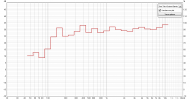As for the acoustic treatment - I don't have anything on the back wall, it's totally "naked"... Would it be a good idea to hang some panels there and which frequencies would potentially benefit?
You could try hanging a heavy blanket temporary to see if it makes any difference, but with your seating position away from the back wall near the center of the room, I doubt it would do much.

